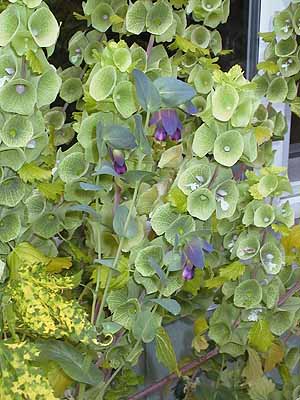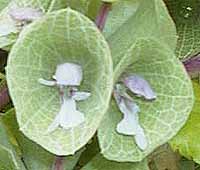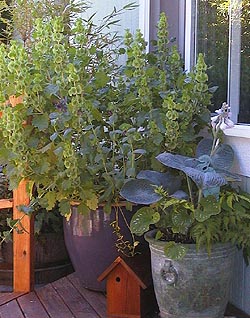Moluccella laevis
BELLS OF IRELAND
Family: Lamiaceae
Pronounced: mol-yoo-SELL-uh LEE-viss
Quick Jumps
Growing Guide
Rainy Side Notes
GROWING GUIDE

Origin:
Western Asia, Turkey, Syria, The Caucasus.
Plant Group:
Half-hardy annual.
Mature size:
Height: 24-36 inches (60-90 cm).
Width: 9 inches (23 cm).
Flowering period:
August.
Flowering attributes:
Green calyx surrounding a small, white, fragrant flower on flower spikes.
Leaf attributes:
Two and a half inch long, pale green leaves.
Light:
Full sun to partial shade.
Soil:
Neutral, moist, well-drained.
Feeding:
Add a complete organic fertilizer when planting. Feed monthly for best results.
Propagation Methods:
Sow seed in situ in spring after last heavy frost, or mid-May to mid-June. To get an early start, sow seed indoors in April. Cover seed lightly. Germinate at temperatures of 55 — 64° F (13 — 18° C). Do not cover with soil, as the seeds need light to germinate. Germination will normally occur within 20-35 days. Harden seedlings off and plant outdoors after last frost.
Pests and Diseases:
Not common.
Rainy Side Notes


The flowers of Moluccella laevis are a symbol of good luck. Whether this is true or not, in our cool maritime climate you will have good luck growing this annual. The flowers, cultivated since 1570, are good cut flowers as well as dried flowers.

Cut flowers will last 7 to 10 days in a vase. What is often mistaken for a green flower is actually the calyx or cup-shaped leaves around the base of the flowers. The actual flower is a small white fragrant flower inside the "bell." When dried, the leaves turn pale beige and will last for years.
The common name, Bells of Ireland, make gardeners mistakenly think the plant originates in Ireland. The plant is named after the Molucca Islands in Indonesia and thought to be from the islands, too. M. laevis is native to Western Asia, Turkey, Syria, and the Caucasus. Syria is where the plant is most often found.
If you have problems with deer, Molucca laevis may prove to be deer and even rabbit resistant in your garden. This annual is easy to start from seed. Although supposedly hard to transplant and recommendations are for starting seed in situ, I have had good success starting the seeds in the greenhouse in early April or approximately 6 weeks before last frost. I soak the seed in water overnight before sowing them. They germinate at cool temperatures of 55 — 64°F (13 — 18°C). I then prick out small seedlings to a 4 inch pot and let them grow on until ready to transplant out after danger of heavy frost has passed. They are hardened off outdoors about a week before they are planted into their permanent positions. This is the best method for container growing. For planting out in the garden, you can sow seed in situ after last frost. When the seedlings come up, thin to 12 inches apart.
Moluccella laevis grows very well in containers. Last year I paired the annual with Cerinthe major 'Purpurascens'. I was quite pleased with the results. The flowers last a long time, even holding up after their peak blooms. The plants grow best during our cool spring and early summer months. They do not do well in hot, humid climates. For the cutting garden, these two plants are great additions.
For cut flowers, cut stem ends and dip briefly into boiling water, and transfer to warm water in a vase. If you want to collect seed for sowing the following year, let flower stalks remain on the plant and collect seed when the seeds turn a dark color and fall out easily.
Debbie Teashon
Photographed in author's garden.

Gardening for the Homebrewer: Grow and Process Plants for Making Beer, Wine, Gruit, Cider, Perry, and More
By co-authors Debbie Teashon (Rainy Side Gardeners) and Wendy Tweton
Copyright Notice | Home | Search | Annuals

